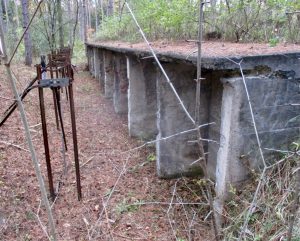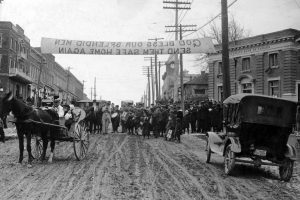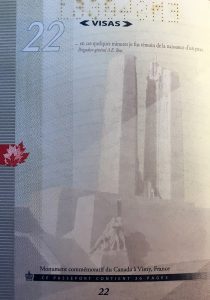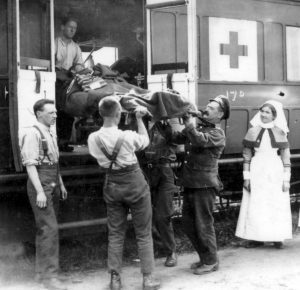
Last April, about the middle of the month, I took a detour from my regular travels. I turned down a dirt road south of town, got out of my car and wandered into the bush. There, just a few feet into the woods lies a bunker containing the rusted frames of century-old shooting targets.
It was here young men, three generations ago, prepared to become part of Canadian wartime history. And as I imagined those young recruits of the 116th (Ontario County) Battalion, practising on their Ross rifles, I think of the photograph – at our township museum and depicted in our downtown mural – of troops leaving for the Great War in 1916.

“God bless our splendid men,” the sign over Brock and Toronto streets reads in the photo and the mural. “Send them safe home again.”
Almost exactly a year later, those same young men – farmers, clerks, journeymen, masons, professionals and even former students – under the command of local lawyer and sitting Member of Parliament Samuel S. Sharpe arrived at the Western Front and a prominent rise northwest of Paris, France, called Vimy Ridge. They were trained to lay new or to repair broken communication lines between advancing Canadian troops and their headquarters while under fire.
“No sooner had our men begun work on the wiring schemes,” the 116th Battalion adjutant wrote on April 9, 1917 the first day of the battle, “than a veritable hail of shells was poured into them from retreating German artillery. In spite of heavy casualties, the work of consolidation was completed.”
It’s the adjutant’s journal of these young Ontario volunteers as well as the photo and mural of their sendoff commemorated in our town that come to my mind every April 9 to 12.

Not the image in my passport.
Last Wednesday, Sean Fraser, the minister for refugees and citizenship, announced that the federal government planned to replace images that are screened into the backgrounds of the 35 pages of your Canadian passport, including the removal of the two grey-green portrayals of the Vimy Memorial and Mother Canada mourning.
The next day (May 11) the Vimy Foundation wrote a press release that it “is disappointed in the decision to remove one of Canada’s most important icons one month after the 106th anniversary of the Battle of Vimy Ridge.”
That was just the start of an avalanche of reaction. On Facebook, comments included: “Cancel culture, this is shameful.” “Feds should give their head a shake.” “An utter disgrace.” “Trudeau is out of control.”
Then, Conservative leader Pierre Poilievre piled on, accusing the Prime Minister of remaking Canada’s passport in his own image. “(Trudeau) deletes Terry Fox, the soldiers who died at Vimy, the City of Quebec and the RCMP from our passport,” Poilievre rants, “to replace it with a colouring book that includes an image of him swimming at Harrington Lake as a boy.”
Well, hold on a second! Let’s all take a deep breath here.

Who says we’re erasing Canadian history? Since when does changing the look of a passport imply the feds are “cancelling” Canadians’ admiration for iconic cancer-cure campaigner Terry Fox, or savaging Canadians’ respect for the legacy of a 150-year-old national police force, much less demeaning the 7,000 Canadian soldiers killed or wounded in the Battle of Vimy Ridge?
Speaking of evolving symbols, have we forgotten the way we came to leave the Canadian Ensign flag behind in favour of the Red Maple Leaf in 1965?
Outrage over changing images in a passport looks a bit to me like false controversy and fake outrage. Instead, each April I stop by the woods south of town to remember the members of this community who felt compelled to serve King and Empire in the Great War, but found a nation instead.

You won’t find Gregory Clark in your passport, but he’s the Canadian reporter who convinced his editor he should interview the volunteers at a Toronto army enlistment office in 1915. Instead, he found himself recruited as a member of the 4th Canadian Mounted Rifles and serving at Vimy. But if you care to acknowledge what happened in the battle, you’ll read his journal:
“For the first time in our history, the four Canadian divisions lined up along the front, shoulder to shoulder,” he wrote from the top of Vimy Ridge on April 9, 1917. “As far as the eye could see, south, north, along the miles of ridge, there were the Canadians. And I experienced my first full sense of nationhood.”
I challenge those who claim they care about preserving Canadian history to repeat such stirring quotes as these, to make such history mandatory in school curriculum, and not worry whether Vimy remains on page 22 of their passport.
Very interesting Ted. Please will you speak again at BeachcombersProbus. in Wasaga beach? We would love to have you on first Tuesday of Nov 7 2023 but will accommodate another date if it suits. Attempts to reach you many times have not worked so far.
Cheers. Susan Mogelin
Very interesting Ted. Please will you speak again at BeachcombersProbus. in Wasaga beach? We would love to have you on first Tuesday of Nov 7 2023 but will accommodate another date if it suits. Attempts to reach you many times have not worked so far.
Cheers. Susan Mogelin and Nalcolm Novar